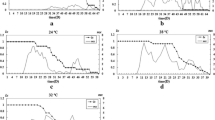Abstract
As part of a study on passive physical control of house-dust mites, a total of 6000 eggs from a population ofDermatophagoides pteronyssinus (Trouessart, 1897) from 17-year-old laboratory cultures were incubated at 60 temperature and relative humidity combinations between 10–35°C and 55–100% RH. Eggs hatched at every combination, although mortality and development time increased between 10–20°C and 30–35°C and below 65% RH. Optimum conditions were 35°C and 80–85% RH. In temperate dry conditions, eggs from a wild population were found to be more resistant to mortality: they developed faster, with 7 times lower mortality than eggs from the laboratory population. This may have been because the laboratory population had become acclimated to the constant near-optimum conditions at which it was kept. Therefore it has been suggested that where laboratory cultures have been used in studies relating to passive physical control, caution should be taken in applying the conclusions to wild populations in the natural house-dust environment.
Similar content being viewed by others
References
Arlian, L.G., 1975. Dehydration and survival of the European house dust mite,Dermatophagoides pteronyssinus. J. Med. Entomol., 12: 437–442.
Arlian, L.G., 1977. Humidity as a factor regulating feeding and water balance of the house dust mitesDermatophagoides farinae andD. pteronyssinus. J. Med. Entomol., 14: 484–488.
Colloff, M.J., 1985. The biology and control of the European house dust miteDermatophagoides pteronyssinus (Trouessart, 1897) (Acari: Pyroglyphidae) in relation to atopic allergy. Ph.D. thesis, University of Glasgow, 104 pp. (unpublished).
Cunnington, A.M., 1971. House dust mites and respiratory allergy: a note on the identity ofDermatophagoides farinae Hughes, 1961. Clin. Allergy, 1: 447–449.
Cunnington, A.M., 1984. Resistance of the grain miteAcarus siro L. (Acarina, Acaridae) to unfavourable physical conditions beyond the limits of its development. Agric. Ecosys. Environ., 11: 319–339.
Dobson, R.M., 1979. Some effects of microclimate on the longevity and development ofDermatophagoides pteronyssinus (Trouessart). Acarologia, 21: 482–486.
Gamal-Eddin, F.M., Abou-Sinna, F.M., Tayel, S.E., Aboul-Atta, A.M., Seif, A.M. and Gaafar, S.M., 1983. Duration of the developmental stages of house dust mitesDermatophagoides farinae andD. pteronyssinus under controlled temperatures and relative humidities to pave the way in front of the workers in the field of house-dust mite bronchial asthma. 1. Pre-imaginal period. J. Egypt. Soc. Parasitol., 13: 319–334.
Heilesen, B., 1946. Studies onAcarus scabiei and scabies. Acta Dermato-Venereol. (suppl. 14). 26: 1–370.
Kinnaird, C.H., 1974. Thermal death point ofDermatophagoides pteronyssinus (Trouessart, 1897) (Astigmata, Pyroglyphidae), the house dust mite. Acarologia, 16: 340–342.
Koekkoek, H.H.M. and Van Bronswijk, J.E.M.H., 1972. Temperature requirements of a house dust mite,Dermatophagoides pteronyssinus, compared with the climate in different habitats of houses. Entomol. Exp. Appl., 15: 438–442.
Korsgaard, J., 1982. Preventitive measures in house-dust allergy. Am. Rev. Respir. Dis., 125: 80–84.
Korsgaard, J., 1983. House dust mites and absolute indoor humidity. Allergy, 38: 85–92.
Murray, A.B. and Ferguson, A.C., 1983. Dust-free bedrooms in the treatment of asthmatic children with house dust or house dust mite allergy: a controlled trial. Pediatrics, 71: 418–422.
Murton, J.J. and Madden, J.L., 1977. Observations on the biology, behaviour and ecology of the house dust miteDermatophagoides pteronyssinus. J. Austr. Entomol. Soc., 16: 281–287.
Oshima, S., Nakamura, Y., Sugita, K., Yoneyama, E., Kitazume, M. and Yoshinaga, Y., 1972. Population density of the mites of floor affected by the moisture content of theTatami mat, with a particular reference for practical prevention. Ann. Rep. Yokohama Inst. Health, 11: 62–69.
Sarsfield, J.K., Gowland, G., Toy, R. and Norman, A.L.E., 1974. Mite-sensitive asthma of child-hood: trial of avoidance measures. Arch. Dis. Child., 49: 716–721.
Spieksma, F.Th.M., 1967. The house-dust miteDermatophagoides pteronyssinus (Trouessart, 1897). Producer of the house-dust allergen (Acari: Psoroptidae). Ph.D. thesis, Leiden State University, The Netherlands, 65 pp.
Van Bronswijk, J.E.M.H., 1972. Food preference of pyroglyphid house dust mites (Acari). Neth. J. Zool., 22: 335–340.
Van Bronswijk, J.E.M.H., 1981. House Dust Biology, Published by the Author, Zoelemond, The Netherlands, 316 pp.
Walshaw, M.J. and Evans, C.C., 1986. Allergen avoidance in house dust mite-sensitive adult asthma. Q. J. Med. (N.S.), 58: 199–215.
Whyte, K.F. and Flenly, D.C., 1986. House dust sensitivity and asthma. Q. J. Med. (N.S.), 58: 89–93.
Winston, P.W. and Bates, D.H., 1960. Saturated solutions for the control of humidity in biological research. Ecology, 41: 232–237.
Author information
Authors and Affiliations
Rights and permissions
About this article
Cite this article
Colloff, M.J. Effects of temperature and relative humidity on development times and mortality of eggs from laboratory and wild populations of the European house-dust miteDermatophagoides pteronyssinus (Acari: Pyroglyphidae). Exp Appl Acarol 3, 279–289 (1987). https://doi.org/10.1007/BF01193165
Accepted:
Issue Date:
DOI: https://doi.org/10.1007/BF01193165




